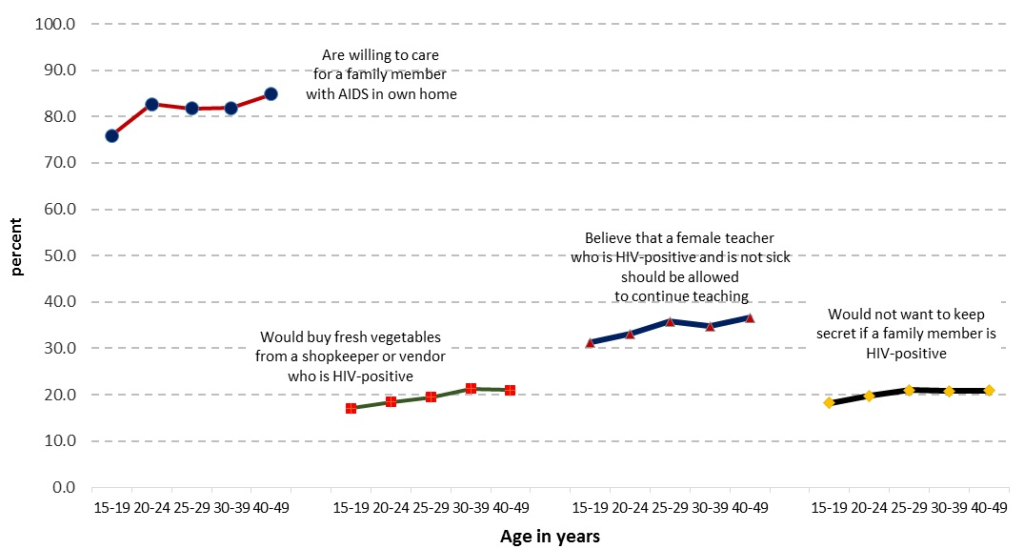One indicator which is both an MDG and the Global AIDS Response Progress Reporting (GARPR; formerly UNGASS) indicator is the percentage of young people who have comprehensive and correct knowledge of HIV prevention and transmission. Comprehensive knowledge is defined as: 1) knowing that consistent use of a condom during sexual intercourse and having just one uninfected faithful partner can reduce the chance of getting HIV, 2) knowing that a healthy-looking person can be HIV-positive, and 3) rejecting the two most common local misconceptions about transmission of HIV.
In Kazakhstan, nearly every woman aged 15-49, or 97.9 percent, have heard of AIDS.
Despite this, the percentage of women who know both main ways of preventing HIV transmission: firstly, having only one faithful uninfected sex partner, and, secondly, using a condom every time during intercourse – was only 65.4 percent.
At the same time, women's awareness about each of the ways is quite high: 82.3 percent of women know that the main way of preventing HIV transmission is to have only one faithful uninfected sex partner and 71.7 percent of women know that using a condom every time during intercourse is one of the most reliable ways to prevent HIV transmission.
Overall, less than half (44.0 percent) of women reject the two most common misconceptions about HIV transmission and know that a healthy looking person can be HIV-positive and only one third of women aged 15-49 have comprehensive knowledge about the ways of HIV transmission and prevention.

Knowledge of mother-to-child HIV transmission is also an important first step for women to seek HIV testing when they are pregnant to avoid infection in the baby. Women should know that HIV can be transmitted during pregnancy, during delivery, and by breastfeeding (through breast milk).
More than half (58.0 percent) of women aged 15-49 years know all three ways of mother-to-child HIV transmission, while at the same time, one in ten (9.6 percent) of women are unaware of any specific means of HIV transmission. The most common is HIV transmission to the child (fetus) through the placenta during pregnancy, which is known to 83.8 percent of women, while 77.3 percent of women know that HIV can be transmitted during delivery. 64.7 percent of women know that HIV can be transmitted from mother to child by breastfeeding.
The indicators on attitudes toward people living with HIV measure stigma and discrimination in the community. Stigma and discrimination are considered low if respondents report an accepting attitude on the following four questions: 1) would you be willing to care for a family member with AIDS in your own home? 2) would you buy fresh vegetables from a shopkeeper or vendor who is HIV-positive? 3) do you think that a female teacher who is HIV-positive should be allowed to continue teaching at school? and 4) would you not want to keep it a secret if a member of your family is HIV-positive?
In Kazakhstan, 90.8 percent of women agree with at least one accepting attitude towards people living with HIV. The most common accepting attitude is the willingness of a woman to care for a family member with AIDS in her own home (82.2 percent).
More than a third of women believe that a female teacher who is HIV-positive, but is not sick should be allowed to continue teaching at school (34.9 percent); every fifth woman is willing to buy fresh vegetables from a shopkeeper or vendor who is HIV-positive (20.1 percent) and would not want to keep it a secret if her family member was HIV-positive (20.5 percent).

In Kazakhstan, 76.0 percent of women reported discriminatory attitudes towards people living with HIV on a combination of the following two indicators, calculated based on negative answers to questions: 1) would buy fresh vegetables from a shopkeeper or vendor who is HIV-positive and 2) think that children living with HIV should be able to attend school with children who are HIV-negative.
Young women and girls aged 15-24 years, and, in particular, aged 15-19 years, are more often less informed about all the ways to prevent HIV transmission and about all the misconceptions related to HIV than older women.

Approximately one in four women aged 15-24 have comprehensive knowledge about HIV (26.7 percent); about half of women aged 15-24 know all three ways of mother-to-child HIV transmission (48.0 percent); and more than two-thirds of women in this age group are aware of a place (facility) to get tested for HIV (71.4 percent).
2.2 percent of women aged 15-24 years express accepting attitudes towards people living with HIV on all four indicators described above; 2.6 percent of young women in urban areas, and 1.7 percent living in rural areas.
78.4 percent of young women report discriminatory attitudes towards people living with HIV, which is comparable to the rate for women aged 15-49 years.